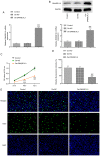DNASE1L3 regulation by transcription factor FOXP2 affects the proliferation, migration, invasion and tube formation of lung adenocarcinoma
- PMID: 36684646
- PMCID: PMC9843492
- DOI: 10.3892/etm.2022.11771
DNASE1L3 regulation by transcription factor FOXP2 affects the proliferation, migration, invasion and tube formation of lung adenocarcinoma
Abstract
Lung adenocarcinoma (LUAD) is prone to bone metastasis, resulting in poor prognosis. The present study aimed to detect the expression of deoxyribonuclease 1-like 3 (DNASE1L3) and forkhead-box P2 (FOXP2) in LUAD cells to investigate the role of DNASE1L3 in the regulation of proliferation, migration, invasion and tube formation of LUAD cells and how FOXP2 affects DNASE1L3 expression. The expression of DNASE1L3 and FOXP2 in LUAD cells was analyzed by reverse transcription-quantitative PCR (RT-qPCR) and western blotting. The transfection efficiency of DNASE1L3 overexpression plasmids, FOXP2 overexpression or interference plasmids into A549 cells was also confirmed by RT-qPCR and western blotting. The viability, proliferation, migration and invasion and tube formation of LUAD cells following transfection was in turn detected by MTT, EdU staining, wound healing, Transwell and tube formation assay. The expression of proteins associated with epithelial-mesenchymal transformation and tube formation was detected by western blotting. Binding between DNASE1L3 and FOXP2 was confirmed by dual-luciferase reporter assay and chromatin immunoprecipitation. Gene Expression Profiling Interactive Analysis database predicted that underexpression of DNASE1L3 in LUAD was associated with poor prognosis. DNASE1L3 expression was decreased in LUAD cells and overexpression of DNASE1L3 inhibited the proliferation, migration, invasion and tube formation of LUAD cells. Transcription factor FOXP2 positively regulated DNASE1L3 transcription in LUAD cells. FOXP2 was also underexpressed in LUAD cells and downregulation of FOXP2 promoted proliferation, migration, invasion and tube formation of LUAD cells, which was reversed by overexpression of DNASE1L3. In conclusion, DNASE1L3 was positively regulated by transcription factor FOXP2 and overexpression inhibited proliferation, migration, invasion and tube formation of LUAD cells.
Keywords: deoxyribonuclease 1-like 3; invasion; lung adenocarcinoma; migration; proliferation.
Copyright: © Meng et al.
Conflict of interest statement
The authors declare that they have no competing interests.
Figures






References
-
- Wang Y, Yang N, Zhang Y, Li L, Han R, Zhu M, Feng M, Chen H, Lizaso A, Qin T, et al. Effective treatment of lung adenocarcinoma harboring EGFR-activating mutation, T790M, and cis-C797S triple mutations by brigatinib and cetuximab combination therapy. J Thorac Oncol. 2020;15:1369–1375. doi: 10.1016/j.jtho.2020.04.014. - DOI - PubMed
-
- Marinelli D, Mazzotta M, Scalera S, Terrenato I, Sperati F, D'Ambrosio L, Pallocca M, Corleone G, Krasniqi E, Pizzuti L, et al. KEAP1-driven co-mutations in lung adenocarcinoma unresponsive to immunotherapy despite high tumor mutational burden. Ann Oncol. 2020;31:1746–1754. doi: 10.1016/j.annonc.2020.08.2105. - DOI - PubMed
LinkOut - more resources
Full Text Sources
